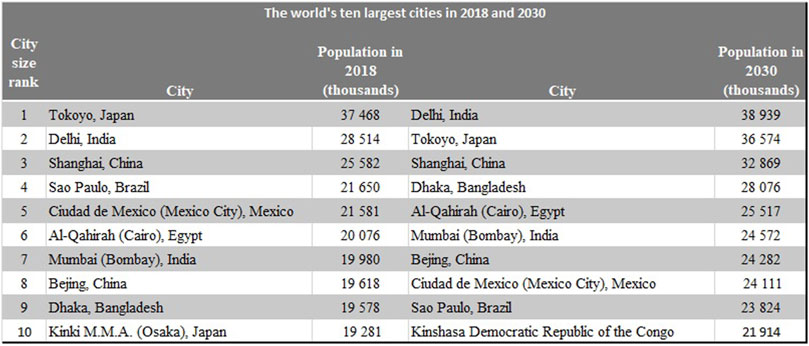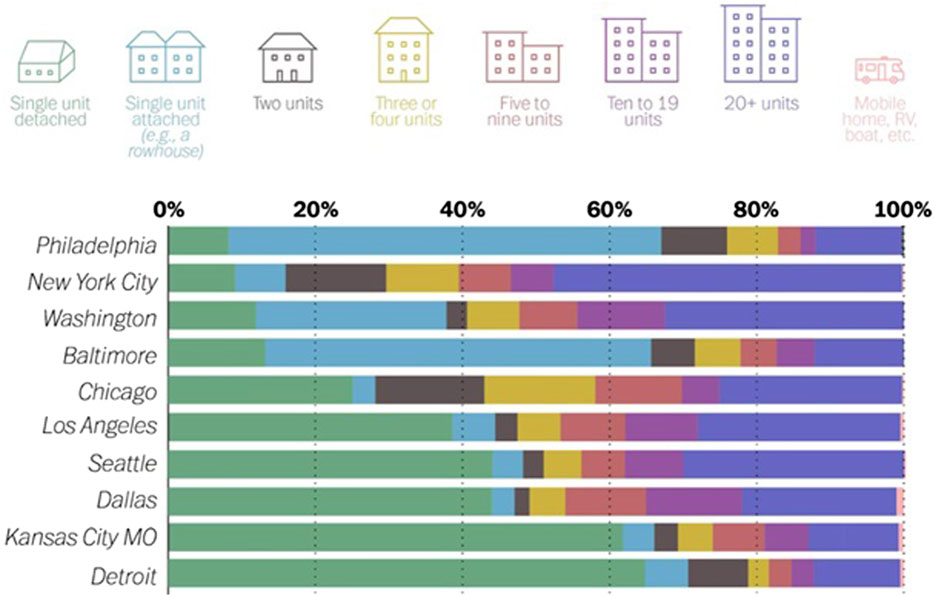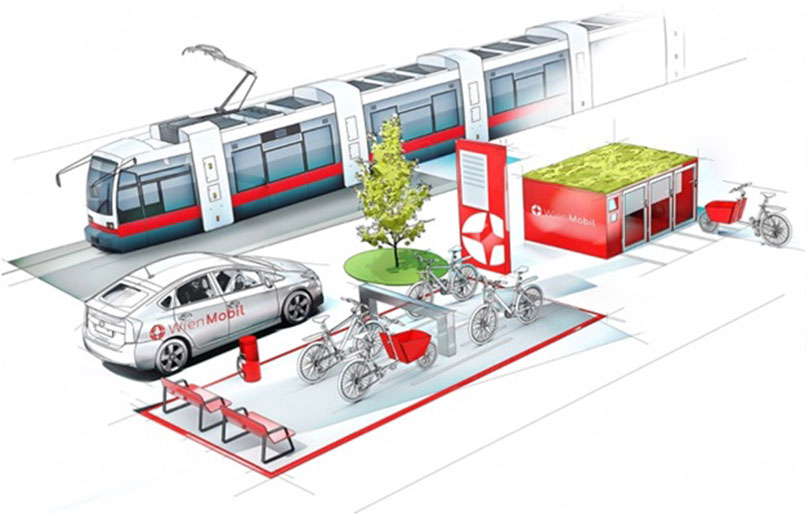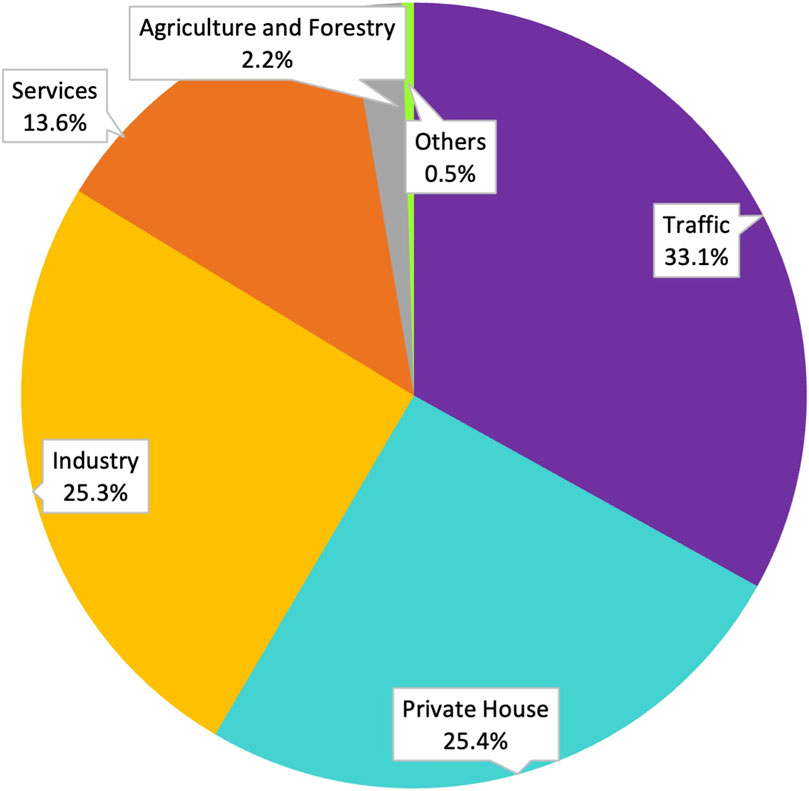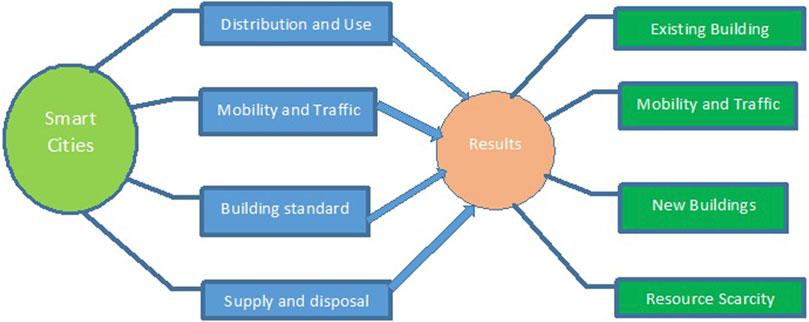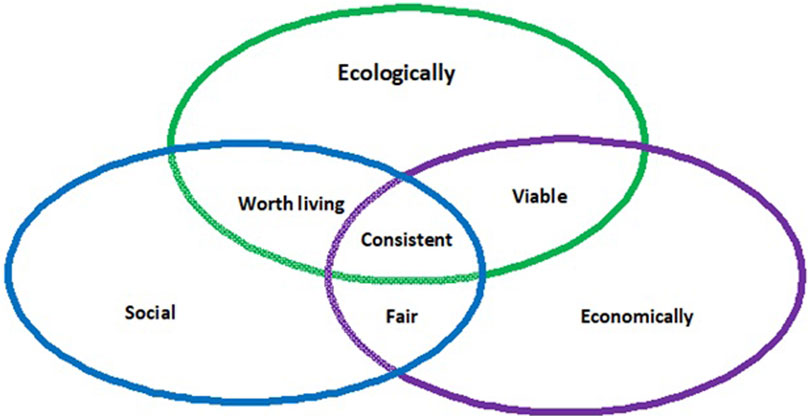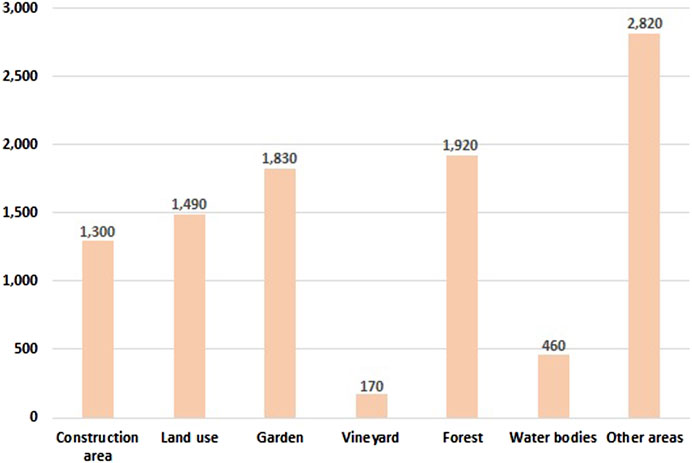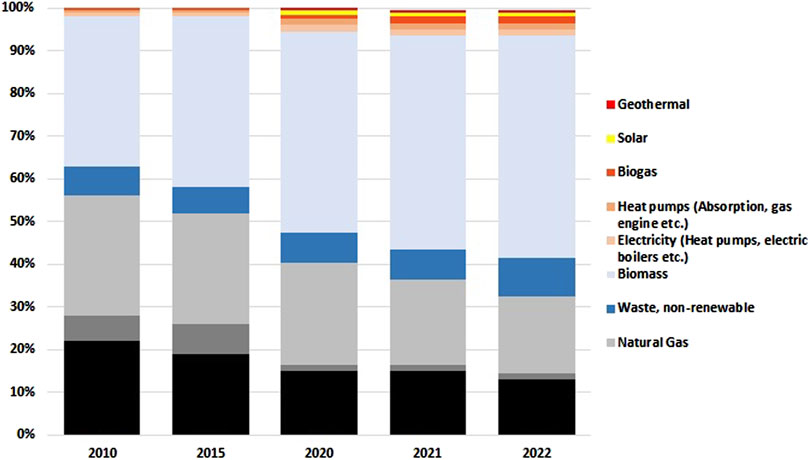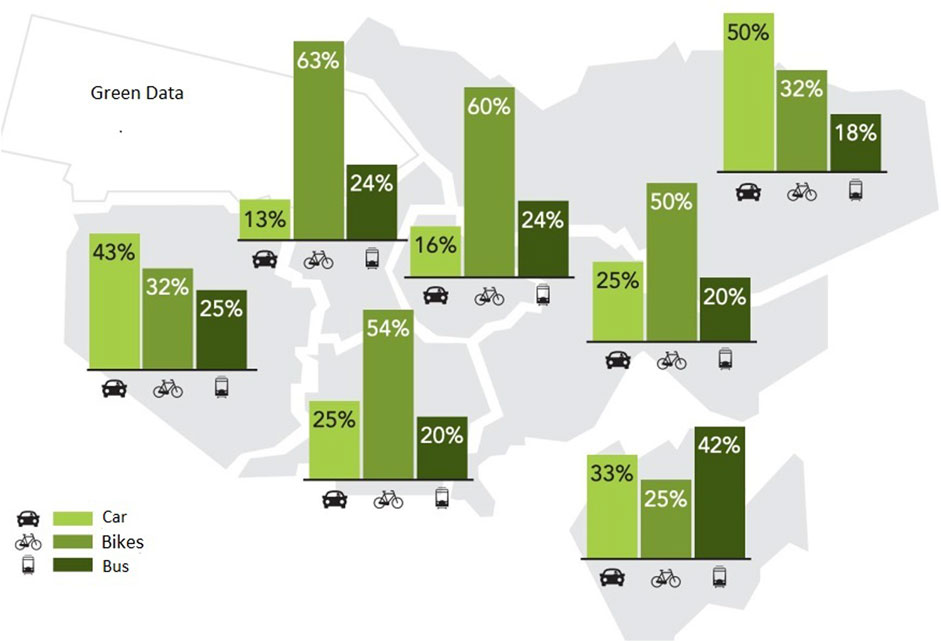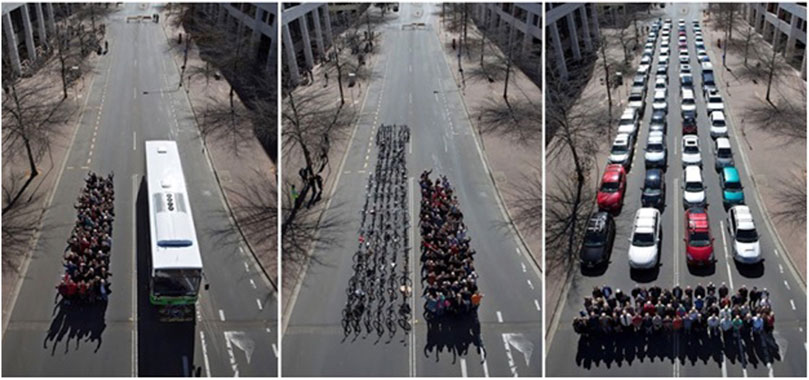The concept of smart cities: a sustainability aspect for future urban development based on different cities
- 1Department of Civil Engineering, College of Engineering, Prince Sattam Bin Abdulaziz University, Alkharj, Saudi Arabia
- 2Landscape Architecture Department, Faculty of Architecture and Planning, King Abdulaziz University, Jeddah, Saudi Arabia
To meet the needs of residents, scientists have suggested the concept of smart cities for urban transformation. Urban green spaces (UGSs) are designed to improve lifestyles. Environmental performance on a global scale is becoming challenging due to climatic changes and rapid advancement. To remedy these issues, the establishment of highly sustainable and healthier ecosystems is a crucial demand, placing an emphasis on the design of smart cities to prevent disease and address the basics of living quality. Urban populations are increasing enormously, which is a strong obstacle to developing a pollution-free environment. This study examines the current developments of cities, especially the sustainability of smart cities, which is required to meet the current demands. In addition to the developments, the ranking of different cities is compared. To explain the climate-related goals, national and international objectives and the legal framework are considered. The study compares the cities of Vienna, Copenhagen, Amsterdam, and Hamburg. The comparison is based on four categories: land distribution and use; mobility and transport; building standards; and supply and disposal. Owing to the high standard of living and its leading position in various rankings, special attention is paid to Vienna. The work is well developed with various components of sustainability and future development to enhance the quality of life and minimize air pollution. Finally, the problems and improvement possibilities of the cities are discussed. The study aims to look at the sustainability goals and projects that could be important in an ecological and sustainable city in the future. The comparison study of different cities shows the importance of smart cities and their effect on health.
Introduction
Between 2050 and 2060, the world population will reach 10 billion (Chen et al., 2020). From a global perspective, as the population grows, so does the number and size of cities. With increasing inhabitants, infrastructure utilization, energy consumption, and environmental pollution also increase, as shown in Figure 1. Cities are significant drivers of climate change; therefore, they threaten our planet without further action. Urban areas are responsible for approximately 70% of energy consumption and 70% of CO2 emissions (Antón et al., 2022; Olén and Lehsten, 2022). The consequences of climate change mean cities are increasingly afflicted by strong heat waves and extreme weather events. These and many other developments are associated with problems, new challenges, and opportunities. Urban planning is therefore focused on a new guiding principle named the “smart city”. It should improve life in the city and meet the goals of the United Nations, thus minimizing pollution, climate change, and high waste of resources, with the help of technological innovations (Bastanchury-López and De-Pablos-Heredero, 2022).
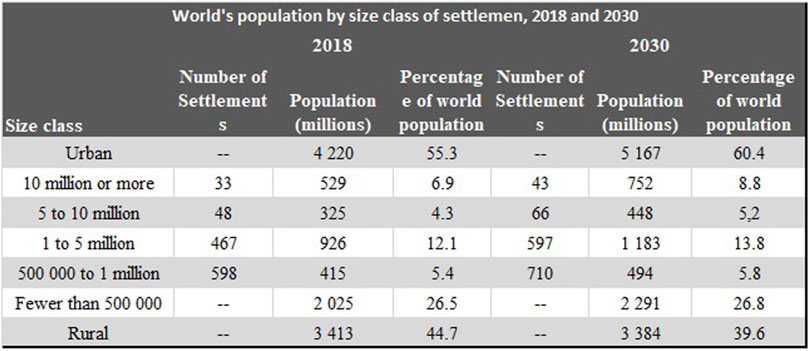
FIGURE 1. World population by size and settlement class (2018 and 2030) (Olén and Lehsten, 2022).
The smart city is used more frequently and is popular with urban planners. Smart cities are seen as the future of urbanism. Billions are invested in them worldwide, but what exactly is a smart city? There are many definitions and approaches, but no universal descriptions. It is, more or less, one vision or expectation of the ideal city of tomorrow, with the current problems cities experience but with a lot of innovative technology solutions. Most of the definitions focus on the areas of quality of life, information technology, and community. More terms emerging from the smart city have developed, such as eco-city, climaneutral city, green city, and sustainable city, indicating the current environmental awareness trend (Bleecker, 2022).
The aim is to build enough living space relatively quickly while ensuring mobility and quality of life. There is no perfect city. This raises the question of how life in a city is most sustainable or efficient to satisfy most people and create a basis for future generations.
To show the current prevailing problem in urban development, in the present study, the different concepts become different cities in the field of smart cities, with special attention paid to the sustainability aspects. In addition, projects and opportunities in the framework of the population’s future developments lead to improving the quality of life.
This study presents the concept of smart cities by comparing the major cities. Smart city development has a major impact on environmental and societal values. Pan et al. (2022) address certain planning system challenges with a major focus on the transparency and deployment of the project with certain model outcomes and parameters. A land-use transportation model is presented by Yamagata and Seya (2013), who discuss the energy model for the Tokyo metropolitan area. The future concept of the smart city, along with the electricity demand and supply model, is simulated. The results show a major contribution of the smart city toward social sustainability with developed models. De Guimarães et al. (2020) show the concept of spending a quality life in smart cities and fulfilling sustainable development goals in an attainable manner. A critical review by Shamsuzzoha et al. (2021) discusses the importance of smart cities and highlights future research problems. A comparison is also developed between cities and summarized with conclusive arguments. For more detailed information on smart cities, readers are referred to Yamagata and Seya (2013), De Guimarães et al. (2020), Shamsuzzoha et al. (2021), and Pan et al., 2022). A thorough discussion about the impact of smart cities and the environment is discussed by Yamagata and Seya (2013) and Shamsuzzoha et al. (2021), who highlight the merits and demerits of cities. Chen et al. (2020), Rehman and Holy (2022), Farkas et al. (2023), Grigoletto et al. (2023), and Honey-Rosés and Zapata (2023) have suggested many corrective measures that should be taken to reduce air pollution and develop smart cities.
The research conducted supportive comparisons to enhance the importance of smart cities. There are four major parameters that are researched to highlight the applicability of the smart city. These four parameters are investigated in four major cities of Europe and are as follows.
• Develop the impact of distribution and use of space.
• Highlight the importance of mobility and traffic.
• What are the important building standards?
• How the supply and disposal impact the city’s performance.
Background
The world is becoming increasingly networked, dependent on technology, and has more intelligent applications in everyday life. Numerous intelligent systems, household appliances, and personal assistants make everyday life more efficient. With the smart city approach, entire cities become more efficient. Smart cities combine infrastructure and technology to improve the quality of life of citizens. Before, cities were more efficient, and a great deal of data needs to be collected to get smarter. The Internet of Things (IoT) has been developed to collect all data from all areas. It allows various objects on the internet to communicate with each other. Many create these intelligent interactions through technological innovations, such as improving public transport, creating accurate traffic reports, or generating real-time energy consumption data. Real-time problems are tracked through constant communication and possible solutions are identified (He et al., 2021; Li et al., 2022).
It can enhance efficiency and thereby improve various aspects of life. In particular, the possibility of improving the quality of life and the beneficial cost reduction makes the smart city concept so interesting. With one step in the future, the handling of the environment will be improved, and the way cities and people work together will be changed. As a result, cities can enjoy a higher quality of life and fewer wasted resources. In summary, a smart city considers the following elements:
Smart economy
A major focus is on business-oriented urban development. Cities should have high productivity, a climate of innovation and market flexibility, and be as flexible as possible to compete globally. The introduction of intelligent technologies in the economic process has become the economy’s engine. This creates an attractive location where the company is efficient, powerful, and can remain competitive (Bastanchury-López and De-Pablos-Heredero, 2022).
Smart people
If the essence of urban development is an individual action, then a city can only be as smart as its citizens. Despite the many technologies, the most important element of a city is often neglected. Any smart city requires smart people, who are the drivers of change. It is about the interaction of technology and city dwellers. People must be able to use and benefit from the technology. Smart devices cannot replace smart citizens. Without citizens, the further development of the cities is not possible. Only through the cooperation of citizens and the corresponding technology will it be possible to improve the many negative aspects of cities (Zenkteler et al., 2022).
Smart governance
Smart governance, smart government, or e-government is the use of technology by the government and hence the future of public services. Smart government should enable certain processes in the government and administration with the help of networked information and communication techniques. Intelligent networked objects and cyber-physical systems are developed to manage public tasks economically and effectively. It is, therefore, about improving the democratic processes and the art of changing how public tasks are carried out. The goal is to make the entire system more transparent and participatory (Wu, 2022).
Smart mobility
Another important element of a smart city is smart mobility, including transport, information, and communication technologies. Mobility issues are especially caused by private transport, which is responsible for a significant proportion of CO2 emissions. No other sector that is so dependent on oil has great potential. Through developments such as e-mobility or the sharing economy, traffic jams and air pollution are reduced and efficiency increases. This leads to the improvement of wellbeing in the city (Scientific Data Curation Team, 2020).
Smart environment
A smart city must ensure viable conditions. This includes the optimization of energy consumption and the use of renewable energy sources. This is the only way to reduce pollution in the environment and create sustainable resource management (Kasznar et al., 2021).
Smart living
Smart living means improving the quality of life. Through a friendly living environment, an intelligent city offers its inhabitants good access to public services, a high individual security level, a wide range of cultural and entertainment offers, a high quality of living, and attractive educational institutions. By improving and developing each of these aspects, the lives of citizens become more comfortable and sustainable (Zhu et al., 2020).
Urbanization
An increasing number of people are moving to cities. Over the past century, most of the world’s inhabitants lived in quite rural areas. By 2018, approximately 55.3% of the world’s population lived in metropolitan areas. By 2030, 60% of people live in urban areas and one in three cities have a population of at least half a million. Owing to the growing city population, an increasing number of megacities (cities with more than 10 million inhabitants, according to the United Nations [UN]) are emerging. In 1950, there were only two megacities but this number rose until 2018. With increasing urbanization, challenges related to housing shortages, healthcare, jobs, energy supply, traffic and the environment emerged (Bătăgan, 2011).
The city of Shenzen, considered China’s technology center, shows how rapidly cities can grow. The city currently has approximately 12 million inhabitants; however, in 1979, Shenzen only had 30,000 inhabitants. Figure 2 shows the 10 largest cities in 2018 according to the number of inhabitants and a forecast of their development in 2030. As shown in Figure 2, Delhi’s population is expected to grow by more than 10 million inhabitants between 2018 and 2030, while the population of the current largest city, Tokyo, will decrease. It predicts New Delhi will overtake Tokyo as the world’s largest city by 2030. What is striking, however, is that the megacities are predominantly located in Asia and Latin America (Kutty et al., 2022; Locurcio et al., 2023).
Housing situation
A high quality of life also means adequate housing of appropriate quality is provided. Housing is a basic need for people because it offers space to live, sleep, drink, and eat. For example, living and quality of life can be assessed by the following aspects: affordability, type of accommodation, size of accommodation (area per person), and construction quality.
Europe
Rents and prices for apartments are rising faster than citizens’ incomes in many European cities. On the one hand, this development is due to the prevailing housing shortage. On the other hand, it is due to the low interest rate phase strengthened by the European Central Bank. On average, in 2017, 41.9% of people in the European Union lived in apartments, 24% in townhouses, and 33.6% in single-family homes. Another factor for assessing housing quality is the availability of space. The overcrowding rate describes the proportion of people living in crowded apartments. It is defined by the number of people in the household, available rooms, household size, and the age of the members and their family situation. In 2017, 15.7% of the EU-28 population lived in overcrowded dwellings. On average, the floor area per person in the EU 28 was 42.56 m2/person (Toli and Murtagh, 2020).
The quality of construction is also a decisive factor in the quality of living. Approximately 14% of the EU 28 population reported having at least one of the following problems: leaking roof, damp walls, floors or foundations, and rotting window frames or floors.
China
Unlike Europe, China has many more metropolitan areas with housing shortages. Rapid population growth and a rapid rise in prices are forcing many people to accept very bad living conditions. The housing shortages mean many live in cage apartments of only 2 m2 in area. The average living space in Chinese cities is 36.9 m/head, although this value is significantly lower in some cities (e.g., Hong Kong). The city of Hong Kong has had the world’s least affordable housing market for 10 years. Although Hong Kong real estate prices average 20.8 times the median household income, in London, for example, it is only 8.2 times greater or 8.4 times in San Francisco. This also affects the average living space of 12 m2/head (Cugurullo et al., 2021).
To counteract population growth and increasing demand, entire cities are being mass-produced in China. Owing to the lack of know-how and the trend toward faster construction, the build quality is very bad. As early as the 1950s, China had many quasi-temporary houses erected, and bamboo was used due to the lack of rebar. Even in the present day, many pay attention to developers only with respect to maximum profit and neglect the life cycle costs and the longevity of buildings. This leads to the demolition of many relatively new buildings.
According to research, the average lifespan of a building is between 25 and 30 years. For comparison, in the UK, it is 132 years, and in the United States, it is 74 years. The constant process of demolition and new construction produces huge amounts of waste. Construction waste accounts for between 30% and 40% of all waste in China’s cities. According to estimates, in 2011, approximately two billion tons of rubble were produced, of which only 5% was recycled.
United States of America (USA)
The United States also increases property prices in line with the global trend. Many experts warn of a real estate bubble, as prices are already above the bubble’s peak. Like Europe, the United States is also in a low interest rate phase, favoring an increase. If all states of the United States are considered, single-family houses are the most popular form of housing. Accordingly, the average living space per person is high. With around 77 m2/capita, the US ranks second in the world. Only in Australia is the average living space (approximately 89 m2/head) higher (Ataman and Tuncer, 2022).
The following can be said about the construction quality: unlike European construction, which is characterized by solid construction, timber frame construction is used in the United States. Even seemingly massive houses only have the appearance of brick walls because the bricks are mostly glued on the outer façade. Even the most expensive houses are built this way. Contrary to that, the inferior construction does not meet the prevailing price level expectations. This also affects longevity. Owing to the common lack of insulation, the components decompose within a few years. Weak beams, side walls, and roofs usually cannot withstand strong winds. The materials used do not even come close to the European level, for example, in new single-glazed windows installed in houses. Thin wall constructions, low storage masses, and non-energy-efficient structures cause high electricity and heating costs. In particular, air conditioners, which are practically in every house, consume very high amounts of power in summer. Figure 3 shows the type of accommodation in the United States.
Traffic and mobility
Mobility behavior
Mobility has long been a basic human need. To ensure sustainable urban development, the mobility behavior of citizens must change. Especially in the big cities, environmentally friendly means of transport must be promoted and expanded. At the same time, the use of motorized vehicles should also be restricted. To change mobility behavior, it is necessary to address the following factors: availability, attitude (upbringing), social status, weather, and costs. When the modal split (distribution of passenger traffic to the different modes of transport) is considered, it turns out that passenger cars are still very dominant (Ahvenniemi et al., 2017; Asadzadeh et al., 2022).
The degree of motorization can be used to compare the number of vehicles between cities and countries. It provides the average number of cars per 1,000 inhabitants. A significant difference is visible if the United States and China are compared. In China, the average number of vehicles is 83, whereas in the United States, the average number is 797.
Public transport network
Public transport is a mode of transport available to every citizen, usually for a fee. Owing to the constant mobility of people, a well-developed transport network also positively affects their quality of life in the cities. It, therefore, also significantly influences the place of work and residence. Compared with motorized private transport, many advantages can be achieved: a larger number of people can be transported in one vehicle, fewer vehicles on the roads, less sealing of the surfaces, lower specific energy consumption per user, lower specific pollutant emissions per user, lower costs, and safer roads.
Public transport in cities is often an attractive, inexpensive, reliable, and sustainable method of locomotion. The amount of space saved should not be ignored. The graphic below shows the potential of transporting 100 people by tram instead of car. However, public transport can be made more efficient and switch to alternative drives to meet climate protection targets. The target network 2025+ was formulated in Austria to increase efficiency. The goal is to provide rural regions with public transport, with the optimal use of the railway. The goal can be achieved with efficient transportation system in the cities.
Sharing
Car sharing makes it possible for all those who do not own a motor vehicle or only occasionally need one to use one. According to studies, many believe that car use in metropolitan areas is a growing problem and causing certain issues, such as parking, congestion, and high emissions. Additionally, with car sharing, the total number of passenger cars is reduced because many households are so focused on the purchase they can do without. In addition, many use a car more deliberately and only when necessary. Many cities have recognized this and want to support this trend. In the meantime, there is a veritable boom among sharing providers. In addition to passenger cars, electric scooters, mopeds, and bicycles are offered. Sharing increases mobility options and promotes sustainable mobility for city residents, which is why it is becoming increasingly popular. In addition, this will relieve the public transport network. Free-floating systems are particularly popular.
The advantage of this is that the vehicles can be parked anywhere and are, therefore, location-independent. All available vehicles can be viewed using an app installed on a smartphone. The billing is per minute used. Fuel, insurance, maintenance, maintenance, and parking fees are included. Therefore, it also speaks to the cost factor against private motor vehicles under certain circumstances. In the event of non-regular use and mileage of less than the car, sharing is cheaper by 10,000 km/year. According to the study by the city of Vienna, conclusions can be drawn about car sharing: private vehicles are replaced by a car-sharing vehicle, savings of 44 million car km/year, CO2 savings of approximately 7,000 tons/year, and car sharing supplements public transport, not a competitor.
Another concept that falls under sharing is mobility points (mobility stations). Various mobility offers, also known as interfaces for changing trains, are offered in one place. The focus is based on electromobility. Figure 4 shows an example of this. In detail, mobility points, car-sharing cars, e-bikes, e-cargo bikes, charging stations, bike storage boxes that can be booked digitally, an information touchscreen, and a good connection to public transport should be included.
E-mobility
The high level of air pollution in cities is usually due to traffic. In Austria, the transport sector accounts for approximately one-third of greenhouse gas emissions. That is why alternative drive technologies, such as e-mobility or hydrogen drives, are in demand more than ever. It is often forgotten that vehicles with electric motors can be environmentally friendly, like the electricity generated by them. Comparison of greenhouse gas and nitrogen oxide emissions for different types of vehicles is shown in Figure 5. In addition, the high weight of the batteries is a disadvantage compared with combustion engines. One thing that must be highlighted is that only avoiding traffic and creating short ways are effective methods for reducing emissions and the required drive energy. If all passenger cars were to be converted to an electric drive, the electricity demand is estimated to increase by 18%. According to a study by the Technical University of Vienna/Energy Economics Group, it would be economically and technically possible to meet the Austrian electricity demand by 2030 to cover renewable energy.
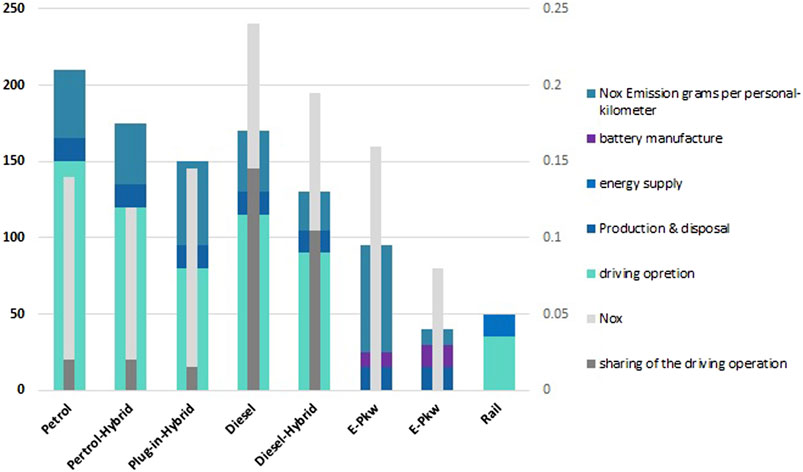
FIGURE 5. Comparison of greenhouse gas and nitrogen oxide emissions for different types of vehicles.
Urban energy technologies
In the coming decades, humanity will have more cities than was the case over the past millennia. For this reason, it is important to equip all new neighborhoods with the latest, most sustainable, and most efficient technologies. The goal is to use as much space as possible to generate energy and use and recycle resources sustainably. Therefore, urban technologies play a key role. The advances in reducing energy requirements develop only very slowly. Despite modern technologies and the possibility of passive zero-energy, the construction of energy-plus houses still predominantly involves conventional buildings constructed with relatively high energy consumption.
Electricity
With digitization and technical advances, total energy use will continue to increase yearly. According to the development, there is an urgent need for action to meet the European Union (EU) targets for achieving renewable energy and energy efficiency. In cities, the focus is still on the usual energy sources, such as gas, district heating, and electricity for local use. Further development of the final energy consumption of all end consumers (such as transport, private households, industry, services and agriculture) is required.
As Figure 6 shows, traffic is the largest consumer at 33.1% of final energy consumption, with private households at 25.4% and industry accounting for a considerable amount at 25.3%. A functioning and secure energy supply is essential for cities. The shift from fossil fuels to renewable energy sources is being addressed in most countries; photovoltaics and wind power play a central role. Particularly with the erection of buildings, there is a high potential for integrating solar modules in open spaces. In addition, intelligent power grids will reduce power consumption and increase efficiency. An evaluation by the city of Vienna shows how great the potential is. Sixty-four percent of an existing roof area of 53 km, i.e., 34 km, is available for photovoltaics or solar thermal energy. Only 36% of the roof areas are not suitable.
Warmth
The heat supply sector also represents a significant part of the total energy requirement. Here, too, there is great potential and a lot of need to catch up.
Combined heat and power (CHP)
With CHP, electricity and heat are generated at the same time. In cities, the waste produced is in modern waste incineration plants, in conjunction with highly efficient flue gas cleaning systems. The resulting waste heat is used for district heating, and the electricity is generated mainly to power the facility or fed into the power grid. With optimal operation, there are potential savings in primary energy compared with a generation of approximately one-third. Depending on the system, efficiencies for heat are typically approximately 70% and can be further increased up to 15% With the help of the efficient use of energy, CO2 emissions and energy costs are reduced.
Biomass
Biomass has the distinct advantage of being storable and renewable and represents a CO2-neutral form of energy. However, the problems lie in the low energy density, the necessary transport logistics, and the increased emissions from combustion, making the decentralized heat supply in urban areas relatively uninteresting. A good possibility of using biomass is central plants, as in Denmark. Switching from fossil fuels to biomass is a decisive step toward CO2 neutrality. It is noted that the power plant is directly connected to ship loading points at sea, which brings a decisive advantage.
Heat pumps
Heat pumps are also considered a sustainable method for future heat supply. The process is based on removing and releasing heat from a medium such as air, water, and earth. Heat pumps can be used for heating in winter and for cooling in summer. Only electrical energy is required for operation. An important metric of heat pumps is the annual performance factor (APF), which provides information about the efficiency of the overall system.
Geothermal
Geothermal energy is based on the use of heat from the Earth. Deep geothermal energy is particularly interesting. Via a borehole at a depth of approximately 4–6 km, underground thermal water can be reached. The hot water is pumped to the surface and, with the help of heat exchangers in one closed circuit, converted into electricity. The residual heat of the water can be used for district heating. It is a sustainable and CO2-free method of heat generation, and its success depends on the geological circumstances. Many projects fail in practice because not all locations are suitable.
Sustainability
Sustainable development meets the needs of the present generation without the possibility of future ones endangering generations to meet their own needs. Sustainability can be divided into three components, resulting in the “three-pillar model of sustainability” results. This contains the subsequent three elements. Sustainability can only be secured if the three strong developed and promoted categories are realized. The sustainability type is shown in Figure 7.
Environmental sustainability
This component involves preserving and protecting the ecosystem for the following generation. This includes considering biodiversity, the natural environment, cultural and landscape areas, and general climate protection. By following these principles, natural economic goods, also referred to as natural capital, are preserved. To improve urban life, cities must become greener. Creating green infrastructure, such as parks, places of recreation, and trees has an often underestimated impact. In addition to the positive effects on the health and wellbeing of people, there is also an improvement in the microclimate. Certain measures can unite cities, especially the building sector contributing to sustainability. According to a study, green facades in cities can have measurable benefits, such as the reduction of local fine dust concentration by up to 20%, reduction of the traffic noise level by up to 10 dB, and reduction of the urban heat island (UHI) effect, and thus also the peak air temperature by 10°C and the cooling energy.
Other city-related parameters that affect the UHI effect are the thermal mass, layout and aspect ratio of roads (grid), and the proportion of green areas. Facade greening benefits dense city centers the most. Access to nature can reduce urban stress, e.g., urban farming and vertical farming. “Urban farming” was developed out of the guerrilla gardening movement, which planted crops in public green spaces and then cultivated them. Many cities now support urban farming. In addition to the economic and food production benefits, there are also benefits in terms of people’s wellbeing. On the one hand, inner-city gardens offer the opportunity for social contact and physical exercise. On the other hand, they may improve eating habits—the consumption of fruit and vegetable increases by 40% among people who participate in gardening.
Owing to the limited space in cities, “vertical farming” was created. The mass production of plant products in urban areas keeps transport routes as short as possible. Cultivation occurs in specially created buildings under ideal growth conditions.
Economic sustainability
The economy is also important to sustainability, as it unites and strongly impacts the environment. Profit maximization must not be the top priority. The economic system must be designed to create a lasting economic equilibrium, price stability, and many job offers. Additionally, protection against the economic exploitation of resources is particularly important.
Social sustainability
Social sustainability relates to people and places them in the foreground. Important issues include the protection of health and social stability. Additionally, developing a functioning society is significant. The aim is to ensure a decent existence and material and intangible basic needs. Furthermore, the satisfaction of the people represents an essential contribution to the increase in the quality of life.
City rankings
With increasing globalization, the competition between cities that want to be leading smart cities increases too. After the concept of a smart city gained popularity, increasing comparisons emerged between cities. Their focus is usually on quality of life. Above all, Vienna benefits from its high position in the international rankings. However, the meaningfulness of the ranking of cities must be critically questioned. City rankings can be targeted while neglecting certain aspects and thus serve as an instrument of city marketing and image building or encourage urban development. Therefore, particular attention should be paid to the publisher, the weighting, the points of comparison, and the procedure.
The economist intelligence unit (EIU) publishes another ranking, the global liveability index (GLI), which ranks cities according to their quality of life as the Mercer study does. A total of 140 cities around the world are rated. The comparison between the sites is based on the challenges that arise for a person’s lifestyle at a given time and place. Each city receives a comfort rating for more than 30 qualitative and quantitative factors. These factors can be broken down into five categories: Stability–weighting 25%; Healthcare–weighting 20%; Culture and environment–weighting 25%; Education–weighting 25%; Infrastructure–weighting 25%. These factors are considered acceptable, uncomfortable, or undesirable and classified as compatible Internal analysts and employees in the respective cities are responsible for evaluating the qualitative factors. Quantitative Factors are calculated based on specific data points. After that, the ratings are merged so that one rating is between 1 and 100 results.
In contrast to the Mercer study, it is striking that only two European cities are in the top 10. Asian cities (average rating: 41.8) had a better average in the ratings. However, strategies are useless if they are not implemented. The implementation is just as important as the cities’ strategies, which is why the implementation of the top 15 cities was also considered and evaluated. Only 8 of the 15 cities show progress in implementation. In ranking cities according to the implementation wheel, Vienna is at the top, followed by Singapore and London.
Materials and methods
The smart city approach meets with many critical voices while enthusiasm is triggered on the other side. However, it should be highlighted that a vast network of sensors, electronic ears, eyes, and noses will turn the future city into a permanent place of surveillance power. Therefore, anyone who has access to the city data can monitor it. Privacy concerns are increasing with the trend toward connected devices. The problem with smart home devices is that they are permanently switched-on sensors (De Las Heras et al., 2020). They record the users’ activities in their living spaces and transmit them to the cloud services of the device manufacturers. To analyze the importance of the smart city, a few parameters are reviewed in this section.
Sustainable development goals
To enable a better and more sustainable future for all, the United Nations drafted 17 goals. They generally deal with the global challenges of humanity. The interconnected goals should be achieved by 2030. Goal 11, sustainable cities and communities, is the most important city-related goal.
• Access adequate, safe, affordable housing, ensure basic services, and upgrade slums.
• Access to safe, cheap, and sustainable transport systems for everyone and expand public transport.
• Inclusive and sustainable urbanization and the ability for participatory-integrated and sustainable settlement planning and administration improvement in all countries.
• They are intensifying efforts to protect and safeguard cultural and natural heritage.
• Reduce the number of deaths caused by disasters and people affected by them, focusing on protecting the poor and those in vulnerable situations.
• They reduce human environmental impact and pay special attention to air quality and waste disposal.
• They are securing access to green spaces and public spaces.
• They promote economic, social, and environmental connections between sites by supporting national and local development planning.
• The number of cities and settlements that plan to increase resource efficiency mitigation and adaptation to climate change, and risk management.
• Assistance to the least developed countries through financial and technical assistance in building more sustainable and resilient buildings using local materials.
Parameters of investigation
The European Union aims to be the first continent to have zero net greenhouse gas emissions by 2050, thus achieving climate neutrality. To achieve this goal, there is a great need for action. It is necessary to power the entire economy with clean energy, and start many more new initiatives. The aim is to eliminate growth-related weaknesses and thus increase competitiveness, productivity, and sustainability. The following goals and strategies were put forward for climate change and energy, which should be achieved by 2030.
• Reduction of greenhouse gas emissions by at least 40% (compared with 1990)
• Share of renewable energies should be at least 32%
• Increase in energy efficiency by at least 32.5%
The research conducted surveys in four major cities and investigated the following parameters: distribution and use of space; mobility and traffic; building standards; and supply and disposal. The flowgraph of the proposed research investigation is shown in Figure 8.
Smart cities
For the period 2013 to 2020, the state of Austria is obliged to reduce greenhouse gas emissions in the area of non-emissions trading sectors by at least 16% compared with 2005. To date, there have been no results in achieving the predetermined goals. The second stage (growth strategy Europe 2030) will last until 2030. With this development legal bases are created, which are very extensive.
Vienna
Vienna is one of the world’s leading cities regarding quality of life. Maintaining this status requires extensive measures and initiatives. For this reason, the city of Vienna has relied on this 2011 smart city concept. Accordingly, an intelligent city should be created so that the current problems of climate change and resource waste are counteracted. Through innovative solutions in mobility and energy, and infrastructure aimed at reducing emissions, the consumption of resources should be reduced. According to the Smart City Wien framework strategy, 2050 climate neutrality can be achieved.
Smart city vienna initiatives
Federal Ministry for Transport, Innovation and Technology (BMVIT): The BMVIT is an important player and source of inspiration in the smart city area. The “City of the Future” program promotes and manages the implementation of many projects, particularly the research and development of new technologies for future cities. The main goal is to reduce energy consumption and use renewable energy in buildings to make them accessible to residents and make the economy more attractive. The BMVIT program is divided into three subject areas: digital planning; construction and operation; plus-energy quarters; and innovative greening technologies.
Climate and energy fund initiative
The Federal Government set up the Climate and Energy Fund in 2007. It serves as an instrument and aid in implementing strategies in research, technology, climate protection, and energy. The Climate and Energy Fund is based on the Climate and Energy Fund Act. In addition to research and development in the fields of sustainable energy technology and climate research, there are projects in the fields of mobility and climate-relevant energy technologies.
Urban innovation vienna
Urban Innovation Vienna is Vienna’s competence center for urban questions about the future. It deals with all strategies and management of the problems many cities are preoccupied with. The center is always in touch with international cities for initiatives, know-how, and international trends, to make experiences available in Vienna and achieve progress. The areas of activity are urban development, energy and climate, digitization, smart city, housing, participation, and city tourism. The center is divided into three departments: Smart City Agency; Energy Center; and Future Cities. Current and future issues become public at specialist workshops and are presented at international conferences.
Distribution and use of space
In Vienna, the proportion of green space is relatively high in international terms. Although the proportion of green was 51% 11 years ago, despite strong population growth, it had increased to 53% in 2019 (see Figure 9). For city expansion projects, the city of Vienna is increasingly focusing on the conversion of old building locations, e.g., old factories or train station areas. The sealed surface that falls on each resident is only 70 m2. To maintain and thus launch the development against UHI, Urban Green Spaces are created and façade greening is promoted. In the next years, 150 facades will be greened, and €500,000, as part of a cooling package for the city, will be invested.
Mobility and traffic
In Vienna, the proportion of journeys made using public transport, by foot, or by bicycle is increasing (75% in 2019). In detail, 38% used public transport, 30% traveled by foot, and 7% used a bicycle. The remaining 25% of journeys involved motor vehicles.
At 38%, Vienna has a very high modal split share compared with public transport in other cities. This is mainly due to the well-developed network and the comparatively cheap annual pass. An annual pass in London is £4,000 and in Hamburg is €1,988, whereas the price in Vienna is only €365. In 2019, Vienna already had 852,000 people with an annual pass. Therefore, the public Transport in Vienna remains as attractive as it has ever been. Wiener Linien is investing massively in expansion and important environmental measures. The current renewal of the bus fleet reduced CO2 emissions by 44%.
In the field of e-mobility, after the expansion of charging options, 60 electric buses will be available by 2023. The hydrogen drive is already in use and tested. In 2027, 10 hydrogen buses will be on the road. In addition, research is being carried out into developing an eco-fuel from sewage sludge, as replacement of auto buses. The following projects have been implemented in the field of mobility.
Green lines
Despite the constant expansion and investments in expansion, the Wiener Linien actively contributes to climate protection. The greening of bus shelters, station buildings, and tracks ensures cooling in the city and thus reduces the urban heat island effect. Energy from underground braking power is more efficient and sustainable. The Viennese Lines such as subways and trams is used for energy recovery.
Bike city
In contrast to car-free settlements, the Bike City concept does not require residents explicitly do without a car. The aim is to make the use of a bicycle as a means of transportation as attractive as possible by having the bicycle delivered right to your doorstep. This could be achieved by the large built-in elevators that accommodate three bikes with their owners. There are also glass boxes, storage brackets, and niches in the arcades for parking the bicycles on each floor.
Smart traffic lights
Traffic lights automatically recognize when pedestrians want to cross. The special technical system developed by the University of Graz and MA 33 is intended to reduce waiting times and thus increase pedestrian comfort. Another step that the City of Vienna strives for is networked traffic lights. These can communicate with each other whereby the traffic light phases are adapted to the current traffic situation, thus reducing congestion. Another step sought is equipping the traffic lights with environmental and weather sensors. Big data analytics and the help of artificial intelligence can be useful in using this data for intelligent traffic control and air quality improvement.
Building standards
Building standards have a significant impact on the useful life of a building. On average, approximately half of the final energy consumption in Vienna is used for heating, cooling, and water heating. That is why it is necessary to give priority to efficiency and sustainability. Given the high population growth, the strategy of the city of Vienna is to construct many new buildings with the lowest energy standard and thermally renovate the building stock, as well as construct renewable energy systems to convert energy sources. With a high-quality thermal renovation, energy consumption and, thus, greenhouse gas emissions will be reduced by up to two-thirds. If the heating system is additionally equipped with a heat pump, converted to solar thermal or district heating, energy generated on-site can reduce greenhouse gas emissions to zero. By paying attention to the city’s renovation, particularly the use of ecological and resource-saving building materials, the CO2 footprint should remain as small as possible.
The City of Vienna has set itself the following goals concerning building standards.
• From 2025, the heat supply for new buildings should be renewable energy or district heating. The 2018 amended new construction ordinance for subsidized housing stipulated that where there is no district heating connection, the heat is always supplied by renewable energy sources. This is to be introduced for all other building categories in 2025.
• Unused buildings should be used for greening and solar energy generation, especially facades and roof areas.
• From 2030, when planning a building, the focus should be on resource conservation. Tools like building information modeling (BIM) can be used. By involving every project participant in the planning, the entire life cycle of a building is considered, which potentially reduces emissions.
• By 2050, 80% of the materials used for demolition and major conversions must be recycled. For this reason, it must already be included in the planning phase that the recyclability of materials at the end of their useful life be respected. In addition, the material composition is an important parameter of the building to record.
According to current information, the Vienna city government plans to introduce a photovoltaic obligation for residential buildings in the building code amendment. Previously, this only applied to industrial buildings.
Supply and disposal
With the Vienna model, the city has a very efficient energy supply compared with other European cities; up to three million tons of CO2 can be saved annually. The reasons for this lie in the individual elements of the Vienna model. This includes the thermal recycling of waste, the use of waste heat with CHP plants, the promotion of renewable energy sources, energy consulting services to increase efficiency, and decentralized forms of generation (solar power plants and/or geothermal energy). In addition to district heating, which accounts for a significant proportion of energy needs, households in Vienna are also covered by the hydroelectric power station in Freudenau (approximately one-third), wind turbines, and photovoltaic (PV) systems supplied with electricity. The PV systems’ main advantage is that they can also be used in densely populated areas.
The strategy is to reduce energy consumption and gradually switch to renewable energy sources. By 2030, 30% of final energy consumption will be covered by renewable energy sources, rising to 70% in 2050. In the field of waste management, the focus is on the five-stage waste hierarchy: 1) waste prevention; 2) preparation for reuse; 3) recycling; 4) other recycling, e.g., energetic recycling; and 5) elimination.
Copenhagen
In 2014, Copenhagen became a Green Party from the European Commission. Owing to rising temperatures and sea levels, the city is particularly committed to eco-innovation and sustainability. Developing new strategies is a remarkable solution, where the experiments can be conducted. This tests intelligent solutions and provides new insights and knowledge bases in the city area. All Smart City initiatives focus on environmental issues in the context of Copenhagen’s commitment to be CO2 neutral city in 2025. The CPH 2025 climate plan describes all the goals that will allow Copenhagen to become the first European climate-neutral city. The city’s green areas account for approximately 22% of the total area. Every inhabitant of Copenhagen has a green space of 31.91 m2, of which 0.68 m2 per person falls on nature reserves.
Mobility and traffic
Copenhagen follows the bicycle approach as an environmentally friendly, flexible, and space-saving means of transport and is therefore considered a cycling paradise. Achieving climate neutrality was set for 2025 in the area of green mobility and the following main objectives were defined.
• 75% of all journeys should be made on foot, by bicycle, or by public transport
• 50% of trips to work or school should be by bike
• Increasing the use of public transport by 20% compared with 2009
• Public transport should be CO2 neutral
To achieve these goals, Copenhagen has set itself to make environmentally friendly means of transport more attractive. Bicycle Traffic: Despite the high proportion of cyclists, many see untapped potential in this area. Among other things are the expansion of routes, the development of innovative cycling solutions, the dissemination of electric bikes for longer distances, and improving conditions for cyclists.
E-mobility/renewable drive forms
Currently, 96% of all car journeys in Denmark are shorter than 50 km. For this reason, the development and wider use of new fuels are promoted. In the coming years, additional charging stations will be required. Hydrogen filling stations will be set up, and the purchase of these vehicles will be promoted. Public transport should become more efficient by 2025, exclusively with electricity or biofuels. In addition, the attractiveness should also be increased. For example, intelligent congestion management reduces travel time. Additionally, improving conditions in transport hubs and measures to facilitate the transfer of other road users are planned.
Building standards
The goal of the CHP Climate Plan 2025 is to reduce overall energy consumption significantly. With the savings in energy consumption, the city wants Copenhagen to achieve great economic benefits. Reducing demand makes it possible to lower investment costs in new energy generation. Compared with 2010, by 2025, heat and electricity consumption in retail and service companies will increase by 20% and electricity consumption in households will be reduced by 10%. In addition, installing solar systems reduces electricity consumption by 1%. There are currently high requirements for keeping energy consumption low. New buildings must be guaranteed to meet future requirements so that optimization can be fulfilled. Energetic retrofitting must be carried out without significant additional costs to be feasible. As a large number of existing buildings were built before the requirements and therefore offer the greatest potential for energy savings, the city is trying to establish contacts to create incentives that lead to greater energy efficiency.
Supply and disposal
The district heating system in Copenhagen supplies 97% of the city’s environmentally friendly and cost-effective heat. In 2017, the renewable energy share is 60.1 %, which shows an increasing tendency of it (see Figure 10). Danish district heating is considered a natural monopoly and was therefore regulated according to the non-profit principle, whereby the costs are regulated by law. The Danish energy target for 2050 is to exclusively use renewable energy sources. Therefore, the storage potential to cover the consumption peaks can be crucial.
To achieve the ambitious climate goals, electricity and heat generation in Copenhagen by 2025 will mainly be based on wind, biomass, and waste. Most will be powered by biomass cogeneration plants (43%), and wind turbines (42%) will be covered. The city of Copenhagen wants a flexible energy system with several energy sources that complement each other. This means energy production can be adjusted if, for example, the wind turbines generate less energy. Despite the already high level of wind power share, 100 new wind turbines with a total capacity of 260 megawatts (MW) will be erected and citizens can participate with shares. The project led to the following findings, among others.
• By coordinating the different energy needs of buildings, an increase in energy efficiency is possible.
• It has been demonstrated that district heating at extremely low temperatures, combined with a heat pump, can be used to supply buildings with hot water.
• Grid-tied batteries can be integrated into the city to provide frequency regulation and peak load coverage.
Instead of demolition and new construction, it was decided to rebuild a former grain silo and thus significantly reduce energy and resource consumption. During the renovation, new window openings for natural light were created for design reasons, and a steel facade should be created for building physics reasons. The former concrete building has been converted into 38 apartments. In addition, there is a ground floor and an attic with public areas, exhibition rooms, and a restaurant.
Amsterdam
Amsterdam is among the first adopters of smart city strategies in Europe, and the strategic approach has been pursued since 2008. For this reason, today, the city is one of the leading smart cities in Europe and was chosen as the European Capital of Innovation by the European Commission.
To ensure the quality of life for future generations, Amsterdam has set a goal to reduce their CO2 emissions by 95% by 2050 compared with 1990 and do without natural gas by 2040. Has the city drafted the Amsterdam Climate Neutral 2050 Roadmap? This document describes the main actors of the emissions, activities, and all goals to be achieved by 2050. The proportion of public green spaces in Amsterdam is only 13%. Steady growth, climate change, and overcrowding of the city require new approaches to green spaces in the city. With the increasing rainfall, regular flooding is a major problem because of the lack of infiltration areas. The Structural Vision Amsterdam 2040 defines the green space policy and, thus, also the minimum amount of green space. In addition to increasing the attractiveness of green spaces, climate protection and biodiversity are important issues. The green agenda sees the creation of 50,000 m2 of green roofs, the protection of healthy trees, an increase in biodiversity, and more nature-friendly buildings.
Mobility and traffic
Amsterdam is considered the premier cycling metropolis in the world because hardly any other city has so much cycling. On average, everyone owns 1.3 bicycles (see Figure 11). Amsterdam city wants to deploy fully electric transportation system as far as possible in 2025, with zero emissions and fully sustainable by 2030. Overall, the urban area traffic accounts for 9% of the CO2 emissions. The main challenge here will be the constraint and reduction in passenger and freight traffic. The city hopes more space will be converted into green spaces. As a result, car ownership in the city is declining, and an increasing number of residents are choosing sustainable means of transport. On average, most trips are on foot, by bike, or by public transport, and 70% occur within Amsterdam. To facilitate mobility, the city is pursuing a strategy of using clean vehicles. Already in 2016, it was stipulated that all taxis have zero emissions by 2025 and buses by 2022. To compensate for the volatility of the renewable energy, the energy is stored in the electric car battery and fed back profitably when demand increases.
Building standards
Emissions from the built environment are currently 28%. The city’s strategy is to switch to a sustainable energy supply and reduce the energy consumption of all buildings. The city of Amsterdam owns many buildings that are currently dependent on natural gas. With the strategy of a gas-free city, the city administration, housing associations, and energy companies agreed to work together on the transition. Areas are gradually being separated from the natural gas network. Private homeowners are offered free advice and financial assistance. At the end of 2018, stricter standards for energy performance (EPC of <0.2) for new buildings were fixed. With these measures, extensive investments, and subsidies, the city wants all buildings to be carbon neutral by 2050 and gas free by 2040. To create a sustainable alternative to natural gas, Amsterdam is investigating the possibility of using geothermal heating. Amsterdam is currently in talks with the state government to create a binding framework by which actual progress can be made.
Supply and disposal
At 51% currently, electricity consumption in Amsterdam is, for the most part, responsible for CO2 emissions. Therefore, if the city is to become climate neutral, a structural change in the energy system away from fossil fuels is necessary. In addition, the economical use of energy sources is necessary. The largest challenge for the electricity sector is to supply sufficient sustainable energy to the city despite the rising electricity demand, population growth, e-mobility, and digitization. The city particularly uses solar panels, wind turbines, and biomass. In 2017, the share of sustainable energy production in total energy consumption was 6%. Most of this is generated by burning biomass in the AEB waste-to-energy plant. The rest comes from wind turbines and solar panels. The city’s goal is to generate as much sustainable energy as possible. To use the possibilities optimally, the available roof area in urban development projects and tenders for solar energy will be used. Financial support will be provided through sustainability funds, energy loans, or the Amsterdam Climate and Energy Fund.
By 2030, the city aims to have 80% of local households taken care of by sustainable energy. According to the regional energy strategy, plants are to generate 550 MW of solar energy and 127 MW of wind energy. Amsterdam has no urban development area comparable with Vienna, Copenhagen, or Hamburg.
Hamburg
Climate protection is also very important in Hamburg, the second-largest city in Germany. As a port city, it is particularly affected by rising sea levels and is therefore forced to operate active flood protection. With the most ambitious climate protection law in Germany, the city wants to reduce its CO2 emissions by 55% by 2030 from 1990 levels and become climate neutral by 2050. In addition, the Senate has drawn up a climate plan with goals and necessary measures.
The urban development project Hamburg-Hafencity aims to contribute to achieving these goals. With 114.1 m2 per inhabitant, Hamburg is one of the greenest cities in the world. According to the climate plan, this is part of the strategy, hot and dry periods counteract them and improve the quality of life. To use the water resource optimally, the priority is landscape planning to let the rainwater seep away as far as possible to make it available for the natural cycle. To use the full potential of the city, Hamburg is pursuing a green roof strategy. In addition to the greenery of the roof area, more green facades will be created.
Mobility and traffic
In 2017, traffic accounted for 28.3% of all CO2 emissions. By 2030, this sector will have to save 4.1 million tons of CO2. A massive expansion of environmentally friendly mobility offers and the switch to renewable drives is necessary. In particular, the following measures will be taken in the area of mobility.
• A massive expansion of charging infrastructure for e-vehicles
• Conversion of car-sharing vehicles to e-vehicles
• Expansion of sharing and on-demand offers
• Expansion of the bicycle infrastructure
• Creation of car-free zones
• Promotion and expansion of shore power for container and cruise ships
• Use of low-emission aircraft
• Emission-free shipping on the Alster
Building standards
To increase the efficiency of buildings, the city implements measures aimed primarily at households, businesses, services, and trade judges. In 2017, approximately 22% of Hamburg’s total emissions were caused by the provision of space heating and hot water.
The savings are primarily due to the renewal of plant engineering with a simultaneous expansion of the district heating network and the installation of heat pumps. Creating funding programs for high-quality energetic refurbishments is also the basis for an efficient and climate-neutral building stock. To set a good example of building, public buildings houses will be the standard efficiency houses from 2025 to 2030.
Supply and disposal
Renewable energy sources will also be important to Hamburg in its efforts to become a green city. The fluctuating energy supply balances and uses energy flexibly, and the city invests in various types of energy storage. An example of this is the production of hydrogen from excess electricity. According to the climate protection program, the proportion of renewable energies will increase to 65% by 2030. When disposing of waste, a higher proportion will be recycled to save resources and emissions.
Results and discussion
The project is characterized, above all, by its sustainable development strategy. Special elements are the reuse of the former port area, efficient and sustainable use of space, the concept of short distances with sustainable mobility, efficient heat supply systems using renewable energy sources, and the certification system for buildings.
Existing buildings
On the way to achieving all climate targets, in addition to developing new neighborhoods, it is also important to improve existing buildings. Although demolition and new construction are often more worthwhile than renovation, it is impossible to completely rebuild an existing city, such as Vienna. The greatest potential, therefore, lies in the energetic refurbishment of existing buildings. The erection of new buildings represents only a disproportionately small proportion of the building and the savings potential. For this reason, the refurbishment rate should be increased. As the city is already investing a lot of money in new projects, especially in the urban development project in Seestadt, the question arises as to whether it would make sense to finance the refurbishment of old buildings elsewhere. Indicative rents in old buildings in Vienna offer landlords only a small yield; therefore, extensive renovations are not economically worthwhile.
As a result, owners of old buildings let the buildings fall into disrepair. For example, incentives could be created through surcharges on the benchmark rent depending on the usage of energy. Another point of criticism of the benchmark rent is that the living space in Vienna is not optimal. People often take up much more living space than they need because they cover a smaller living space, and they would have to pay more in newer residential buildings.
Mobility and traffic
Electric cars are only as environmentally friendly as the electricity that supplies them—assuming that the renewable energy sources can save much CO2. Nevertheless, integrating electric cars takes place very slowly. The reasons for this lie in the high initial cost and the shorter range compared with vehicles that run on fossil fuels. In visions of the future, it is often forgotten that the space problem and the stressed areas remain the same. New powertrains and technologies such as autonomous driving and electric and hydrogen cars alone will not improve the traffic situation. Both do not automatically lead to less traffic. As can be seen in Figure 12, the car’s footprint is enormous. From this, it would make sense in the future to focus more on public transport and the reason to set bicycle as part of the trffic.
The city of Amsterdam shows how well the bicycle works as a means of transport. The residents have realized that riding a bike is faster and cheaper. It is therefore important that the residents of the cities themselves use the advantages and attractiveness of this means of transport. The city administration has an important role in expanding the cycle path infrastructure and creating an interface to public transportation. Amsterdam has more bicycles than people because people ride their bikes to the subway and ride another bike to work, for example. The bicycle can solve the problem of the last mile. Instead of building garages for cars, they should be built for bikes. Covered corridors are necessary for bicycle traffic to make them less dependent on the weather. The latter must dominate the natural competition between passenger cars and bicycles by creating measures.
New buildings
It will be accounted as high standard building with longer sustainability. However, despite the current options, erecting buildings in the PlusEnergy standard is mostly out of the question. For reasons of cost, this standard was not used. The belief that energy-efficient construction is more expensive is a prejudice. The reduced costs reduce the additional costs incurred at the start of construction in the life cycle of buildings. Added to this is the higher dependency on external energy supply, which in turn involves the risk of fluctuating energy prices.
Resource scarcity
The construction sector is one of the largest consumers of raw materials worldwide. Buildings and entire cities can be used as huge raw material mines, referred to as the future. Under the term “urban mining”, it is understood that recycling material will be extracted from buildings at the end of their useful life. Urban mining thus makes a significant contribution to resource efficiency and reduces emissions as primary raw materials are used less. At the same time, complex treatments or the landfilling of unusable materials is avoided. The demarcation of old building is based on the material used and the life of the building compared to the buildings, which were new constructed. Owing to the great advances in building materials (use of composites, chemical treatment, and bonding of materials), these become unusable or perhaps must be disposed of as hazardous waste. Constructing recyclable buildings, with a record kept of all the materials used, must become an important basis of construction to close the resource cycle.
Conclusion and future work
There is an increasing sealing of green spaces, and the residents often have to live in cramped conditions. Our finding shows that planning urban spaces for a high quality of life is more important than ever. Owing to climatic developments, cities must be more sustainable, livable, and better for the next-generation. The research conducted here shows that smart cities can help with this. So far, however, there are no uniform definitions and delimitations of the term “smart city”. The broader public often use the term as a synonym for technically advanced cities. The term applies much more to all activities related to smart technologies and strategies for sustainability.
Our finding shows that cities are very complex systems with numerous fields of action. Only by close collaboration between stakeholders can solutions be developed to improve cities and make them intelligent and sustainable. Another challenge is the certain uniqueness of the cities. No two cities are identical, so no uniform smart city plan exists. Despite this, cooperation between several cities may lead to a win-win situation due to the different degrees of implementation. Success results from a high degree of commitment and interest from the responsible parties.
For several decades, humanity has been using more resources than the Earth can regenerate in a year, which is about to change. The cities described have the common goal of protecting the environment and reducing the ecological footprint. Each of these cities tracked their climate neutrality strategy based on a climate plan that is intended to be fully implemented by 2050 at the latest (by 2025 for Stockholm). Using new technologies to mitigate the damage we have done to our planet is possibly the only remaining option.
The findings show that the cities listed are green cities trying many smart solutions that reduce emissions and reduce carbon dioxide. They are also characterized by efficient, environmentally friendly, and well-developed public transport networks. The combination of high quality of life and intelligent technologies allows the cities described to feature highly in the international city rankings. However, the rankings should be viewed critically. Despite the high-ranking European cities, the Asian metropolises are, on average, significantly more advanced.
Building smart cities will not only help make our daily lives more efficient and organized but also reduce the impact of cities on the environment. Only time will tell whether this will be enough to slow down the climate crisis. The proposed research aims to compare the major cities and investigate diverse features to implant the concept of smart cities. The research shows that the implementation of smart cities has improved green infrastructure and air quality. The outcomes of the current study are green urban spaces, low air pollution, good quality air index, and a healthy lifestyle. These factors improve the economy of the country and attract tourists.
Data availability statement
The original contributions presented in the study are included in the article/Supplementary material, further inquiries can be directed to the corresponding author.
Author contributions
AA contributed to the conception and design of the study. AA organized the database. AA performed the statistical analysis. AA wrote the manuscript. AA contributed to manuscript revision and read and approved the submitted version. All authors contributed to the article and approved the submitted version.
Acknowledgments
The author extends his appreciation to the Deputyship for Research and Innovation, Ministry of Education in Saudi Arabia for funding this research through project number IF2/PSAU/2022/03/21915.
Conflict of interest
The authors declare that the research was conducted in the absence of any commercial or financial relationships that could be construed as a potential conflict of interest.
Publisher’s note
All claims expressed in this article are solely those of the authors and do not necessarily represent those of their affiliated organizations, or those of the publisher, the editors and the reviewers. Any product that may be evaluated in this article, or claim that may be made by its manufacturer, is not guaranteed or endorsed by the publisher.
References
Ahvenniemi, H., Huovila, A., Pinto-Seppä, I., and Airaksinen, M. (2017). What are the differences between sustainable and smart cities? Cities 60, 234–245. doi:10.1016/j.cities.2016.09.009
Antón, J. I., Böheim, R., and Winter-Ebmer, R. (2022). The effect of migration on unionization in Austria. Empir. Econ. 63 (5), 2693–2720. doi:10.1007/s00181-022-02220-w
Asadzadeh, A., Kötter, T., Fekete, A., Moghadas, M., Alizadeh, M., Zebardast, E., et al. (2022). Urbanization, migration, and the challenges of resilience thinking in urban planning: Insights from two contrasting planning systems in Germany and Iran. Cities 125, 103642. doi:10.1016/j.cities.2022.103642
Ataman, C., and Tuncer, B. (2022). Urban interventions and participation tools in urban design processes: A systematic review and thematic analysis (1995–2021). Sustain Cities Soc. 76, 103462. doi:10.1016/j.scs.2021.103462
Bastanchury-López, M. T., and De-Pablos-Heredero, C. (2022). A bibliometric analysis on smart cities related to land use. Land 11 (12), 2132. doi:10.3390/land11122132
Bleecker, J. (2022). Design fiction: A short essay on design, science, fact, and fiction. Mach. Learn City Appl. Archit. Urban Des., 561–578.
Chen, Y., Guo, F., Wang, J., Cai, W., Wang, C., and Wang, K. (2020). Provincial and gridded population projection for China under shared socioeconomic pathways from 2010 to 2100. Sci. Data 7 (1), 83. doi:10.1038/s41597-020-0421-y
Cugurullo, F., Acheampong, R. A., Gueriau, M., and Dusparic, I. (2021). The transition to autonomous cars, the redesign of cities and the future of urban sustainability. Urban Geogr. 42 (6), 833–859. doi:10.1080/02723638.2020.1746096
De Guimarães, J. C. F., Severo, E. A., Júnior, L. A. F., Da Costa, W. P. L. B., and Salmoria, F. T. (2020). Governance and quality of life in smart cities: Towards sustainable development goals. J. Clean. Prod. 253, 119926. doi:10.1016/j.jclepro.2019.119926
Farkas, J. Z., Hoyk, E., de Morais, M. B., and Csomós, G. (2023). A systematic review of urban green space research over the last 30 years: A bibliometric analysis. Heliyon 9 (2), e13406. doi:10.1016/j.heliyon.2023.e13406
Grigoletto, A., Toselli, S., Zijlema, W., Marquez, S., Triguero-Mas, M., Gidlow, C., et al. (2023). Restoration in mental health after visiting urban green spaces, who is most affected? Comparison between good/poor mental health in four European cities. Environ. Res. 223, 115397. doi:10.1016/j.envres.2023.115397
He, C., Liu, Z., Wu, J., Pan, X., Fang, Z., Li, J., et al. (2021). Future global urban water scarcity and potential solutions. Nat. Commun. 12 (1), 4667. doi:10.1038/s41467-021-25026-3
Honey-Rosés, J., and Zapata, O. (2023). Green spaces with fewer people improve self-reported affective experience and mood. Int. J. Environ. Res. Public Health 20 (2), 1219. doi:10.3390/ijerph20021219
Kasznar, A. P. P., Hammad, A. W., Najjar, M., Linhares Qualharini, E., Figueiredo, K., Soares, C. A. P., et al. (2021). Multiple dimensions of smart cities’ infrastructure: A review. Buildings 11 (2), 73. doi:10.3390/buildings11020073
Kutty, A. A., Kucukvar, M., Abdella, G. M., Bulak, M. E., and Onat, N. C. (2022). Sustainability performance of European smart cities: A novel DEA approach with double frontiers. Sustain Cities Soc. 81, 103777. doi:10.1016/j.scs.2022.103777
Li, G., Fang, C., Li, Y., Wang, Z., Sun, S., He, S., et al. (2022). Global impacts of future urban expansion on terrestrial vertebrate diversity. Nat. Commun. 13 (1), 1628. doi:10.1038/s41467-022-29324-2
Locurcio, M., Tajani, F., and Anelli, D. (2023). Sustainable urban planning models for new smart cities and effective management of land take dynamics. Land 12, 621. doi:10.3390/land12030621
Olén, N. B., and Lehsten, V. (2022). High-resolution global population projections dataset developed with CMIP6 RCP and SSP scenarios for year 2010–2100. Data Brief. 40, 107804. doi:10.1016/j.dib.2022.107804
Pan, H., Kwak, Y., and Deal, B. (2022). Participatory development of planning support systems to improve empowerment and localization. J. Urban Technol. 29 (2), 33–54. doi:10.1080/10630732.2022.2031431
Rehman, S., and Holy, O. (2022). Is green and sustainable technological innovation a potential driver of environmental performance? An empirical investigation across the ASEAN region. Front. Environ. Sci. 10. doi:10.3389/fenvs.2022.958203
Scientific Data Curation Team (2020). Metadata record for: Provincial and gridded population projection for China under shared socioeconomic pathways from 2010 to 2100. Available from: https://springernature.figshare.com/articles/Metadata_record_for_Provincial_and_gridded_population_projection_for_China_under_shared_socioeconomic_pathways_from_2010_to_2100/11898405.
Shamsuzzoha, A., Nieminen, J., Piya, S., and Rutledge, K. (2021). Smart city for sustainable environment: A comparison of participatory strategies from Helsinki, Singapore and London. Cities 114, 103194. doi:10.1016/j.cities.2021.103194
Toli, A. M., and Murtagh, N. (2020). The concept of sustainability in smart city definitions. Front. Built Environ. 6, 77. doi:10.3389/fbuil.2020.00077
Wu, F. (2022). Land financialization and the financing of urban development in China. Land Use Policy 112, 104412. doi:10.1016/j.landusepol.2019.104412
Yamagata, Y., and Seya, H. (2013). Simulating a future smart city: An integrated land use-energy model. Appl. Energy 112, 1466–1474. doi:10.1016/j.apenergy.2013.01.061
Zenkteler, M., Darchen, S., Mateo-Babiano, I., and Baffour, B. (2022). Home-based work in cities: In search of an appropriate urban planning response. Futures 135, 102494. doi:10.1016/j.futures.2019.102494
Keywords: land distribution, built environment, green infrastructure, climate change, smart cities, urban environmental sustainability, eco-friendly behavior
Citation: Addas A (2023) The concept of smart cities: a sustainability aspect for future urban development based on different cities. Front. Environ. Sci. 11:1241593. doi: 10.3389/fenvs.2023.1241593
Received: 16 June 2023; Accepted: 03 August 2023;
Published: 25 August 2023.
Edited by:
Shazia Rehman, Central South University, ChinaReviewed by:
Haozhi Pan, Shanghai Jiao Tong University, ChinaTausif Zahid, Riphah International University (Lahore), Pakistan
Ali Raza, University of Engineering and Technology, Lahore, Pakistan
Copyright © 2023 Addas. This is an open-access article distributed under the terms of the Creative Commons Attribution License (CC BY). The use, distribution or reproduction in other forums is permitted, provided the original author(s) and the copyright owner(s) are credited and that the original publication in this journal is cited, in accordance with accepted academic practice. No use, distribution or reproduction is permitted which does not comply with these terms.
*Correspondence: Abdullah Addas, a.addas@psau.edu.sa
 Abdullah Addas
Abdullah Addas